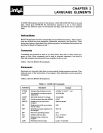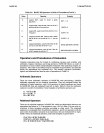
BASIC-80
Language Elements
Octal Integer Constants
Octal integer constants are identified by the suffix Q following the numeric value.
The numerals
0-7
are
used as octal digits. Each digit represents 3 bits
of
data.
Some
octal iQteger constants are:
Octal
Decimal
Equivalent
7720
506
44440
2340
7Q
7
Single-Precision Floating-Point Constants
Single-precision floating-point constants are identified by the suffix ! following the
numeric value, by
the
letter E identifying the exponent in scientific notation,
or
by
the presence
of
a decimal point in a number having seven
or
fewer digits. Floating-
point numbers
in
the
range ± 1.2 x
10-
38
to ± 3.4 x
10
38
are represented with seven
digits
of
accuracy.
Each single-precision floating-point constant requires
four
bytes
of
memory.
Because this is
half
the storage required
by
double-precision floating-point con-
stants,
and
because single-precision arithmetic
is
quicker
than
double-precision
arithmetic,
it's
a good idea
to
use single-precision wherever possible for floating-
point operators.
Some single-precision floating-point constants are:
142!
-1.414
6.259371
E-09
Double-Precision Floating-Point Constants
Double-precision floating-point constants are identified by the suffix # following the
numeric value, by
the
letter D identifying the exponent in scientific notation,
or
by
having more
than
seven digits. Floating-point numbers in the range ± 2.2 x
10-
308
to
± 1.8 x
10
308
are represented with
16
digits
of
accuracy.
Each double-precision floating-point constant requires eight bytes
of
memory. Some
double-precision floating-point constants are:
-2.001317921012
11235813213455
24.2#
Variables
Numeric variables represent numeric values
that
can
change during program execu-
tion. These
can
be
of
three types, like numeric constants: integer, single-precision
floating-point, or double-precision floating-point. Numeric variables are repre-
sented by one
or
two characters followed by
an
optional type identifier suffix.
The
first character must be a letter; the second, which
is
optional, may be any
alphanumeric character.
If
the variable name contains more
than
two characters
besides a type identifier suffix, the rest
of
the variable name characters are ignored.
No words used as
BASIC-80 instruction words may be used within variable names.
2-7


















